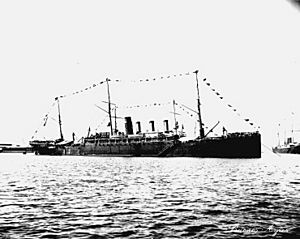Spanish transport Buenos Aires (1887) facts for kids
class="infobox " style="float: right; clear: right; width: 315px; border-spacing: 2px; text-align: left; font-size: 90%;"
| colspan="2" style="text-align: center; font-size: 90%; line-height: 1.5em;" | 
|}
The Buenos Aires was a large ship that started its life carrying goods for trade. In 1898, during the Spanish–American War, the Spanish Navy needed more ships. They took over Buenos Aires to use it as a transport ship. This meant it would carry soldiers and supplies instead of regular cargo.
Contents
| History | |
|---|---|
| Name | Buenos Aires |
| Namesake | Buenos Aires, the capital of Argentina |
| Builder | William Denny and Brothers |
| Completed | 1887 |
| Acquired | 1898 |
| Fate | Returned to mercantile service 1898; scrapped 1942 |
| Notes | In mercantile service 1887–1898 and 1898–1942 |
| General characteristics | |
| Type | Transport |
| Propulsion | steam |
Buenos Aires: From Trade to War
The ship Buenos Aires was built in 1887. For about 11 years, it worked as a normal trading ship. But in June 1898, the Spanish–American War was happening. Spain needed many ships to help with the war effort. So, the Spanish Navy took control of Buenos Aires to use it for military transport.
A Special Mission to the Philippines
As a transport ship, Buenos Aires joined a special group of ships. This group was led by Rear Admiral Manuel de Camara. Their big mission was to travel to the Philippines. They were supposed to fight the United States Navy squadron there, led by Commodore George Dewey. They also had to deliver 4,000 Spanish Army soldiers to help defend the Philippines.
Admiral Camara's group of ships was quite large. It included a battleship called Pelayo and an armored cruiser named Emperador Carlos V. There were also other ships like auxiliary cruisers Patriota and Rapido, and three destroyers: Audaz, Osado, and Proserpina. Besides Buenos Aires, there were other transport ships like Panay, Alfonso XII, and Antonio Lopez. Four ships that carried coal also joined them. This whole group left the port of Cadiz on June 16, 1898.
Journey Through the Suez Canal
On June 17, 1898, Buenos Aires and the other ships passed Gibraltar. Two of the transport ships, Alfonso XII and Antonio Lopez, left the group to sail to the Caribbean on their own.
The rest of the squadron, including Buenos Aires, arrived at Port Said, Egypt, on June 26, 1898. They needed to get more coal for their journey. However, the Egyptian government did not allow them to get coal. This was because Egypt wanted to stay neutral, meaning they did not want to pick sides in the war. This decision was made on June 30, 1898.
Called Back Home
By July 5, 1898, Buenos Aires and the rest of Camara's squadron reached Suez. Around this time, a big event happened in the war. Another Spanish fleet, led by Vice Admiral Pascual Cervera y Topete, was completely defeated in the Battle of Santiago de Cuba. This battle freed up the powerful ships of the U.S. Navy.
Because of this, Spain became worried about its own coast. The Spanish Ministry of Marine (like their navy department) decided to call Camara's squadron back home. So, on July 7, 1898, the order came to return to Spain. Buenos Aires and the other ships left Suez on July 11, 1898, and sailed back to Spain.
Later Years
By the end of July 1898, the war was almost over. Buenos Aires was no longer needed by the navy. It went back to being a commercial ship, carrying goods for trade. The ship had a very long life after its short time in the war. Buenos Aires was finally taken apart for scrap metal in 1942.
See also
 In Spanish: Buenos Aires (buque, 1887) para niños
In Spanish: Buenos Aires (buque, 1887) para niños

